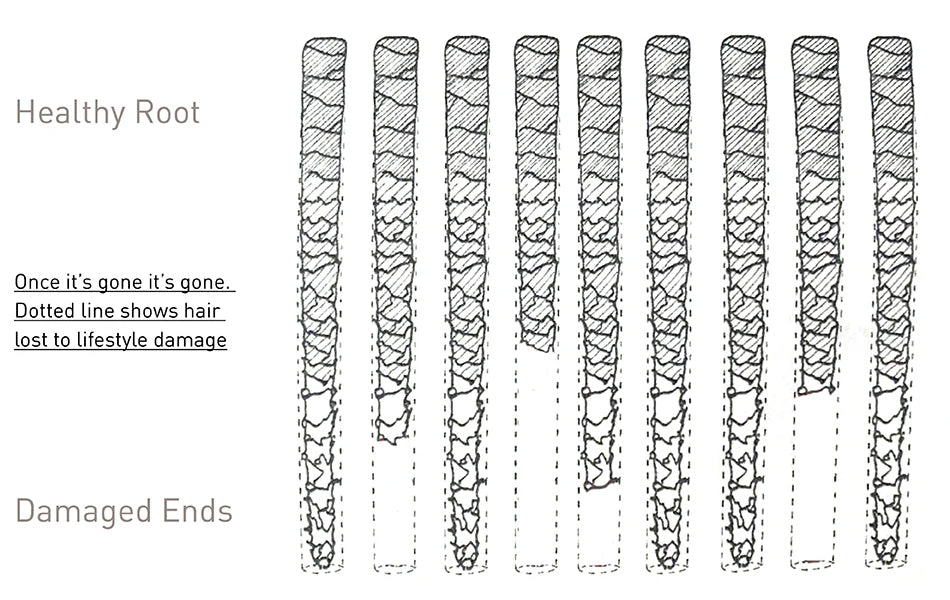New to Van Clarke? Subscribe to our newsletter for 15% off your first order. Start your haircare journey today.
New to Van Clarke? Subscribe to our newsletter for 15% off your first order. Start your haircare journey today.
October 16, 2024

1. Miss X sees 'hair loss' as a whole hair having fallen out and gone.
2. Mrs Y interprets 'hair loss' as the hair still being there, but each hair half as thick, maybe split and broken too.
Both are right. But most people fear No.1 whilst suffering the most loss of volume from No.2.
Most people think of hair loss as the complete and permanent loss of hairs. Hair loss of this type is usually gradual throughout life, with 3-5 year cycles of: growth - fall - rest - regrow. In between are spurts of temporary hair fall linked to seasons, stress and hormones.
Few people get the microscope out for a stock check across the scalp. Phew! Still 107,586 hairs. Most people assess overall volume by how it looks, feels and behaves, and as to whether there’s less than usual. Enough hair or not.
By far the most common impact on overall volume is partial loss – a thinning down of the hair shaft linked to lifestyle factors. This diminishing also weakens the hair shaft, leading to more breakage which further reduces volume. Partial hair loss is something you have the most control over.
 Once out of the scalp, hair is no longer connected to the body’s metabolism, so cannot repair itself. This is why it’s so important to protect and replenish the hair continually, so that it doesn’t thin down and become roughened and brittle. Once it’s gone it’s gone.
Once out of the scalp, hair is no longer connected to the body’s metabolism, so cannot repair itself. This is why it’s so important to protect and replenish the hair continually, so that it doesn’t thin down and become roughened and brittle. Once it’s gone it’s gone.
LifeSaver and LifeSaver UV Treatment are uniquely effective for maintaining the health and thickness of hair against what life throws at it. Living in a nunnery also works, but may not be as much fun.
 What shrinks hair?
What shrinks hair?
Hair is 97% protein and 3% water. Anything that destabilises the protein structure and dehydrates the hair will lead to a breakdown of the protein core and a thinning hair shaft.
Aggressive products – weaken and dehydrate hair. Avoid silicone additives in fake hair 'care' products
Excessive heat styling – a better haircut and styling techniques saves hot styling time and hair stress
Seawater and Pool water – salts and chlorine weaken hair. Use LifeSaver or LifeSaver UV Treatment to protect – then rinse after swimming and reapply.
Sunlight – UV rays destabilise the protein structure. Use hats and LifeSaver UV Treatment in the sun.

Common Misunderstandings
Many people think they can neglect and trash their hair, because if they then give themselves time for a treatment it’s all better again. But it really isn’t. All damage to hair results in shrinkage and loss. That is permanent until new hair grows through to replace it, which depending on the length of hair can be several years.
Some confusion lies in the partial disguise that some products give to the appearance of hair. With hair damage comes a lifting of the cuticle. This is what gives a roughness to the hair. Difficult to comb, and more prone to breakage, it also absorbs more light making it appear flat and dull. Many products can temporarily smooth this cuticle back down, silicones and plasticizers being the most common.
 But these are temporary masks. The hair underneath is still naturally rougher because of the damage, and along with that, the structure is hollowed out and thinner. Nothing can permanently replace those lost hair molecules and restore thin brittle ends to full supple root hair. Worse still, the silicone masks continue to dry out the new hair in the same way, so the condition never recovers.
But these are temporary masks. The hair underneath is still naturally rougher because of the damage, and along with that, the structure is hollowed out and thinner. Nothing can permanently replace those lost hair molecules and restore thin brittle ends to full supple root hair. Worse still, the silicone masks continue to dry out the new hair in the same way, so the condition never recovers.
Read… Haircare Dirty Secrets #1
Read… Why Silicone is Bad for Your Hair
Read… Why Silicone-free
The journey back to healthy hair cannot be made in a few weeks no matter how many treatments are applied to the damaged ends. It takes time for old damaged hair to be replaced by new protected hair under your new hair care regime.

Michael Van Clarke
April 15, 2025
When an industry gangs up on its customers to suit itself, it never ends well. Eventually the mis-selling and other scandals come to light, then the providers close ranks, obfuscate, and gaslight the customers into thinking they are in the wrong or they themselves are the problem.
April 14, 2025
April 11, 2025